Samsung Galaxy Note 10.1 (2014 Edition) Review
by Brian Klug & Anand Lal Shimpi on October 1, 2013 9:00 AM EST- Posted in
- Tablets
- Samsung
- Mobile
- Galaxy Note 10.1
GPU & Performance
Although Exynos 5420 fixes the big underlying issue with Samsung’s silicon on the CPU front, it’s actually the GPU that sees the most dramatic change. ARM once again wins Samsung’s GPU business and equipped the Exynos 5420 with a 6-core Mali-T628, replacing the PowerVR SGX544MP3 from the previous Exynos 5410. Overall performance takes a huge step forward. Looking at T-Rex HD (offscreen) we see the best example of where the Mali-T628MP6 lands: about 11% slower than Adreno 330 and 8% behind IMG’s PowerVR G6430 in the iPhone 5s. It’s definitely a competitive GPU with the latest and greatest from IMG and Qualcomm, but not faster than either. It’s incredible to think of just how far we’ve come. It wasn’t too long ago that we were complaining about non-Apple SoCs not taking GPU performance seriously, but here we are talking about competitive performance across the big three ARM vendors.
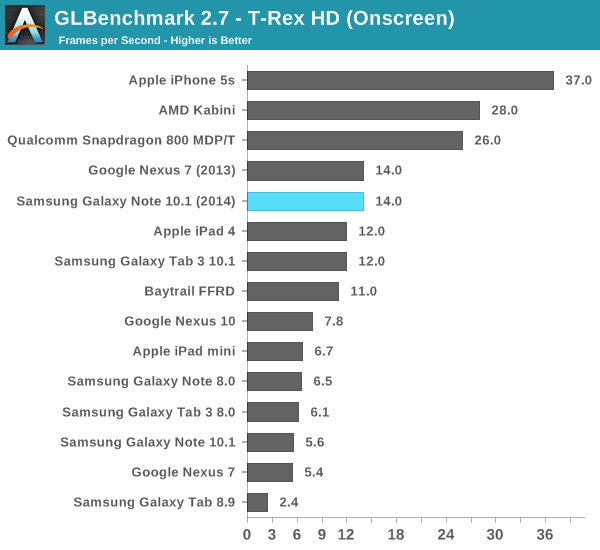
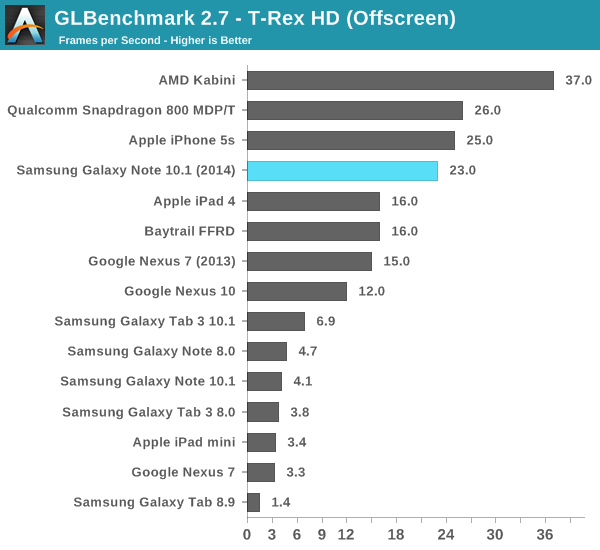
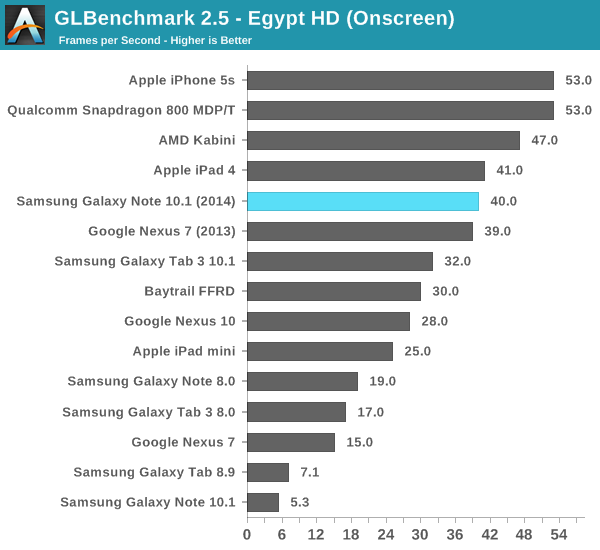
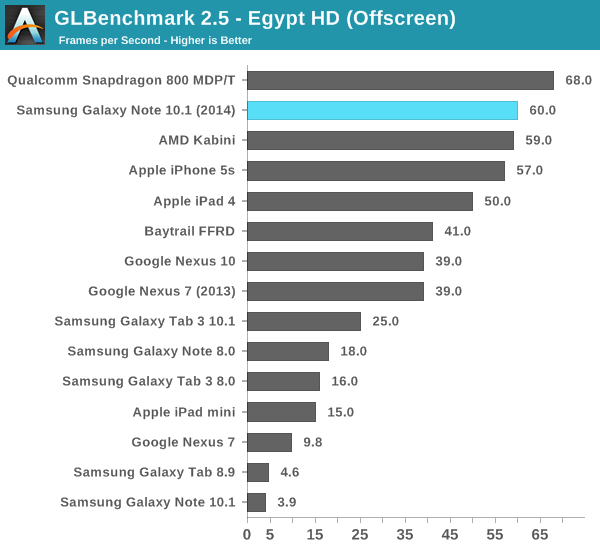
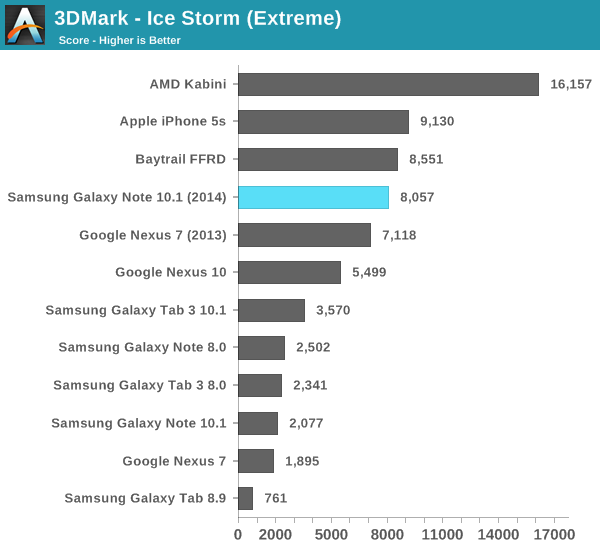


NAND Performance
We've been tracking storage performance on these devices for a little while now and have noticed forward progress over the generations. The new Note 10.1 does reasonably well in our IO tests, with its strengths being sequential read and random write performance (arguably the two more important metrics). Since the tablet ships with Android 4.3 it should feature FSTRIM support (something we're still verifying on the 2014 Edition), which will help keep NAND performance high as long as you don't fill up all of your storage (remember: try to keep ~20% of the internal NAND free at all times).
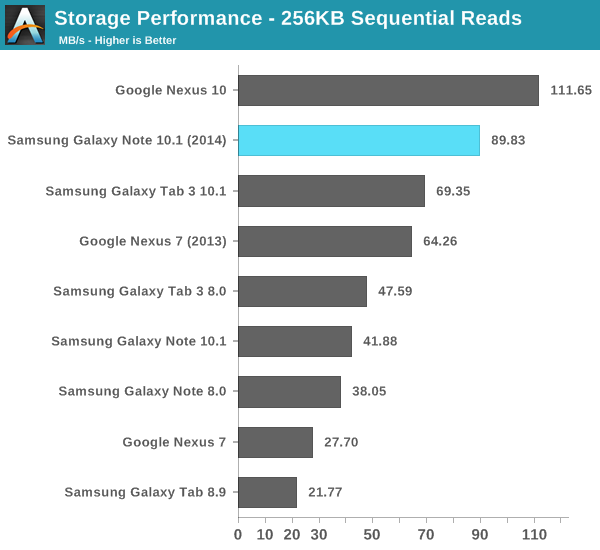

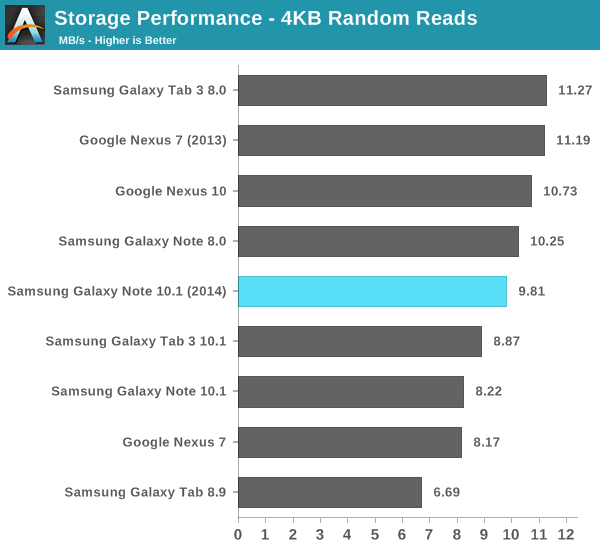











97 Comments
View All Comments
danbob999 - Tuesday, October 1, 2013 - link
Not only HPC. Pretty much any multi-threaded CPU test. And these do not include javascript benchmarks, which as stated many times on this web site, tests the software more than the hardware.AndreiLux - Wednesday, October 2, 2013 - link
In the end MHz and number of cores is irrelevant because:http://chip-architect.com/news/Apple_A7_Samsung_54...
Their two cores are as big as four A15's. Clocks are also irrelevant as seen with Qualcomm vs ARM designs.
What in the end matters is perf/mm² and that dictates the better design.
MySchizoBuddy - Tuesday, October 1, 2013 - link
so according to you apple's MINOR modifications has improved performance to such a level that even a quad core cannot beat it. Damn Apple engineers must be super geniuses.ddriver - Wednesday, October 2, 2013 - link
No, it does not beat a quad core, one core of the A7 beats one core of the snapdragon 800 by about 20%. Anand only uses single threaded tests to compare the two processors, and not even native code, but JS running on different VMs.Using all the cores, the snapdragon is way faster than A7, that is why no such benchmarks are present to ruing the myth of A7's performance.
KPOM - Friday, October 4, 2013 - link
And how many mobile apps make full use of multi-core processors? Furthermore, thermal limitations prevent the quad-core processors from achieving maximum performance all the time, hence the whole controversy over "rigged" benchmark results. Let's face it. Apple made the right decision in sticking with a dual-core design with faster single-core performance. For what people use mobile devices to do today, it's the best balance between performance and power consumption.ESC2000 - Thursday, October 10, 2013 - link
But then they stuck a tiny battery in there (guess they had to because of the iPhone tiny size) so there's no actual battery life advantage. In fact, the first night I had my iPhone it died over night and the alarm didn't go off, causing me to be late to work. The reason appeared to be that it couldn't handle pushing email every fifteen minutes. So yeah I don't think the iPhone stands out for its battery... Look at the Motorola phones for amazing battery life.abazigal - Friday, October 11, 2013 - link
How much battery life did your iphone have when you went to sleep? I typically plug in my iphone to charge before turning in for the night, and even if I didn't, it boasts impressive standby capabilities and the battery life dipped very little throughout the night (around 5-6% max for 6 hours, or 1% per hour).abazigal - Friday, October 11, 2013 - link
Either that, or the engineers in the other companies are totally inept for failing to make those small changes to optimise their chips for better performance and energy savings.name99 - Tuesday, October 1, 2013 - link
Please tell us which ARM reference design it is that Apple "modified slightly"...You seem deeply confused about what CPU design is and how it works. What would you define as a non"conventional arm v8 chip"?
steven75 - Wednesday, October 2, 2013 - link
You should probably read Anandtech's own review of the A7 chip.